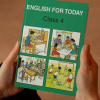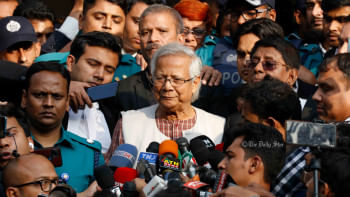The perils of our English education

In the second test match against the Kiwis, Mirpur's pitch was rated "unsatisfactory" by the ICC, and it received one demerit point. Fifteen wickets fell on the first day, and the match was likely to be over the following day. Nature intervened, and the rain gave the visitors time and space to recompose and register a tremendous comeback. Our famous spin-friendly hunting ground turned out to be a booby trap that exposed our foundational weakness.
This year, there was a dip in the pass rate of our school-ending certificate examination. Experts rightly blamed poor performance as well as the new evaluation system in English and mathematics for the overall decline. Some even think it was an aftershock of "auto-pass" and "graciousness" shown during the pandemic. The fact remains that our students lack the literacy and numeracy skills to pass the test. There has been an invented pitch for them to perform well, but the moment there is a real test, most of them fail. The irony is that the fault lies not with the examinees but with the system (that is the local and international policymakers, government agencies, teachers, and textbooks).
The problem of students underperforming in English is perennial. Given the colonial legacy, one would hope that our proficiency level would be satisfactory. Even some years ago, we ranked 71 in the world with low proficiency in the EF English Proficiency Index (EF EPI). This year, the situation has improved, as we ranked 60 among 113 countries based on those who took the proficiency test devised by EF.
This does not, however, give us a true picture, as the test takers are only a sample size of the population who have different agendas for sitting for the test. The SSC performance is a better marker to understand our national situation as it is the end product of an education policy that is designed to empower the future generation with the skill sets to prepare for the emerging job market, which is fast becoming global in orientation.
We expect our students to become global actors. However, with national results in a compromised condition, analogous to our Mirpur pitch, our students may perform in the short term, but the danger is that we are doing long-term damage to our youth, from whom we are expecting a demographic dividend.
I was looking at the English for Today textbooks that have recently been launched under the learner-centred model. My curiosity was piqued as the pedagogical model comes from one of the world leaders in secondary education, Finland. Some of the creative projects related to wellness and the art of living, introduced by the new model, have already sparked criticism. The absence of competitive testing and creative engagement in classrooms have confused students, teachers, and guardians alike.
The foreword highlights extensive research and piloting programmes that contributed to the production of these textbooks. I am not an expert on material development, but I can comment on the textbook as a user.
As a teacher at the tertiary level, we have to negotiate with the supply of students that come through the secondary and higher-secondary systems. And we have to spend three graduate-level courses to address issues that we expect our students to learn about earlier. Why we must have courses with remedial English and basic paragraph or essay writing is a mystery similar to the twists and turns on a Mirpur pitch.
These basic English courses are mandatory for students across the discipline, as the medium of instruction, at least in private universities, is in English. And the quality of English instruction plays a pivotal role in shaping students' linguistic competence and critical thinking skills. English proficiency is not merely a matter of linguistic competence but also a gateway to accessing a wealth of information and perspectives from around the world.
Language, as the author of the first modern English dictionary, Samuel Johnson, puts it, is the dress of thought. Going through the newly-designed textbooks, I could not help but lament the fact that we have not given our students enough gear to challenge their thoughts for intellectual growth. I feel there is a potential risk of dumbing down the English curriculum in Bangladesh.
As a parent whose daughter went to different international schools on multiple continents, I know that the communicative competence that the Bangladeshi textbooks are aiming for is below par with the difficulty level not only of the developed countries but also of the one that I experienced while studying at Bangla-medium schools four decades ago.
The new textbooks have simplified language content, limiting the exposure of students to complex structures, vocabulary, and critical thinking exercises. We are regressing. This is a bold claim. Let me give examples.
In Class 5, students are being introduced to parts of speech such as nouns, pronouns, and articles for the first time, and that too in less than 10 sentences. The text adopts translanguaging and includes Bangla translations of the definitions. Within the span of 10 pages (filled with illustrations), they are asked to form questions and punctuation. The focus seems to be more on speaking practices and classroom drills. One wonders where the symbolic capital will come from to engage in such classroom activities. The listening audios available on the website are mostly short exchanges.
A reason for this situation could be that we do not have the required teachers to align with international standards. But we need to believe that the right investment in our children can make a whole lot of difference. Look at the linguistic competence of the second-generation expatriate Bangladeshis and try to understand how schooling has made all the difference.
I shall end with one example of the definition of poetry used in the Class 6 textbook. Children are supposed to fill up the blanks in the poem after listening to a recitation. Then the teacher gives this note. "A poem is a kind of literary writing. It has some characteristics. Two of them are Stanza and Rhyming." Then it defines rhyming as "the similar-sounding words at the ends of the alternate lines of a poem."
While the last sentence refers to just one type of rhyming, the definition of literary is vague, to say the least. And the language construction cannot be a model for the students to emulate. I understand why the editors opt for texts with local writers to contextualise the education, but that does not give us any excuse to lower the standard of language. With such simple expressions, we will end up with people without the skills to negotiate global issues. And the populist textbook-making will create more perils for the nation in the days to come.
Dr Shamsad Mortuza is professor of English at Dhaka University.
Views expressed in this article are the author's own.
Follow The Daily Star Opinion on Facebook for the latest opinions, commentaries and analyses by experts and professionals. To contribute your article or letter to The Daily Star Opinion, see our guidelines for submission.

 For all latest news, follow The Daily Star's Google News channel.
For all latest news, follow The Daily Star's Google News channel. 









Comments